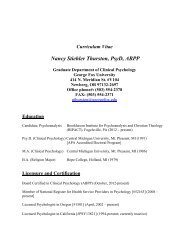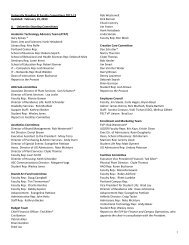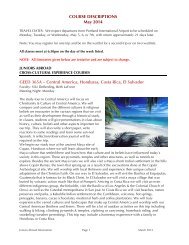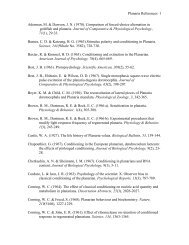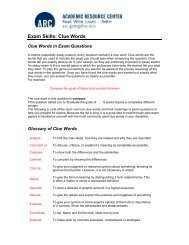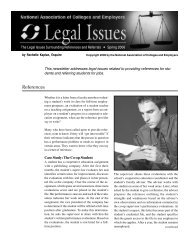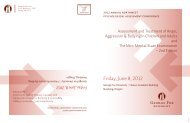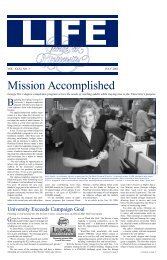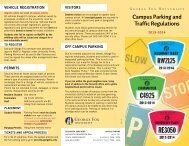Teaching Non-Native English Speakers - George Fox University
Teaching Non-Native English Speakers - George Fox University
Teaching Non-Native English Speakers - George Fox University
Create successful ePaper yourself
Turn your PDF publications into a flip-book with our unique Google optimized e-Paper software.
Tips for making your teaching more accessible to non-native <strong>English</strong> speakers in your<br />
classes<br />
1. Monitor how you speak.<br />
• Pause for a couple of extra beats between sentences.<br />
• After using an idiomatic phrase, briefly rephrase it (e.g., after saying “he let the<br />
cat out of the bag,” add “he told someone the secret”) before continuing the<br />
narrative.<br />
• Clarify cultural allusions that may be unfamiliar to people from another country.<br />
2. Use visual aids.<br />
• Writing key words on the board or otherwise providing visual cues helps students<br />
process meaning more readily.<br />
• If you give a quiz question orally, also project or write a written version.<br />
• Print legibly.<br />
• Provide written information about homework assignments and exams.<br />
3. Adjust questioning procedures.<br />
• After posing a question, repeat it and allow some time (about 5 seconds) to pass<br />
before calling on someone for an answer.<br />
• Pose a question to the whole class and tell students to share their answer with a<br />
person near them. After students have shared their answers with partners, ask for<br />
individual responses. (This engages all students to a higher degree and allows<br />
non-native <strong>English</strong> speakers a chance to process the question and rehearse an<br />
answer in a lower-stress interaction. It also breaks the ice and gives students a<br />
chance to interact with each other, which could help them make connections with<br />
potential study partners.)<br />
• Vary your questioning process. Sometimes call for volunteers; sometimes call on<br />
people by name. Many non-native <strong>English</strong> speakers find it easier to answer when<br />
called upon individually rather than by volunteering.<br />
• Don’t just ask “Does everyone understand?” or “Do you have any questions?”.<br />
Instead, ask students content questions to elicit what their actual understanding is<br />
(“Tell me [or a partner] what you understand about X” or ask a specific question<br />
about a point you want to be sure the class has noticed. This may be orally or in<br />
writing—not as a quiz, but as feedback to you.)<br />
4. Encourage cross-cultural peer collaboration.<br />
• Encourage students to sit next to a student from a different culture rather than<br />
forming a cluster of students from the same culture.<br />
• Depending on the purpose of the activity, distribute non-native speakers in groups<br />
with native <strong>English</strong> speakers.<br />
• Devise small-group tasks that require the active participation and contribution of<br />
each group member. (Students may struggle to follow the conversation and get a<br />
word in edgewise unless the group is careful to include them.)<br />
• Monitor groups and coach students on adjusting their speech, if necessary, to<br />
enable non-native <strong>English</strong> students to understand and participate.
• When appropriate, include small-group tasks that provide an opportunity for<br />
cross-cultural exchange, and follow up on insights that emerge.<br />
• Encourage students to study together outside of class.<br />
5. Establish and maintain clear standards and practices.<br />
• When a student turns in work that is unsatisfactory or late, or fails to turn in an<br />
assignment, apply your usual policies and be sure to explain the reason for this to<br />
the student. Doing otherwise sets up the expectation that policies do not apply<br />
equally, and this is not in the best interest of the student.<br />
• If you notice signs of plagiarism—sentences in a paper that show significantly<br />
different levels of academic <strong>English</strong> skills, for example—address them directly<br />
and consistently.<br />
• For exams, we advise that you forbid use of electronic translators or other aids by<br />
non-native <strong>English</strong> speakers. Rather, encourage students to ask you questions if<br />
they do not understand words or questions on the exam.<br />
• Provide testing contexts and formats that minimize the temptation and opportunity<br />
for cheating. (Most students do not cheat, but a small percentage may find ways to<br />
collaborate if the opportunity presents itself.)<br />
• If you allow some students to use extra time to complete an in-class exam, offer<br />
this option to any student in the class.<br />
6. Allow some time for adjustment.<br />
• Often a student has some difficulty at the beginning of the semester but, upon<br />
becoming oriented to the class requirements, expectations, and procedures, is able<br />
to fulfill course requirements or even excel.<br />
• When you become aware that a student may be struggling as a result of <strong>English</strong><br />
language skills or cultural differences, meet with the student. Share your<br />
concerns, listen to the student’s perspective, and clarify your expectations for<br />
student performance. Let the student know about available resources (see #7).<br />
Watch for improvement. Keep the student’s advisor informed (see #8).<br />
7. Encourage students to use available resources.<br />
• <strong>Non</strong>-native <strong>English</strong> speaking students in their first semester have a faculty tutor<br />
that you should refer them to for assistance.<br />
• Refer students to the Academic Resource Center for writing and other academic<br />
assistance.<br />
• If there is a department lab and/or tutor, refer students to these.<br />
• Encourage struggling students to record your lectures and to use resources that<br />
you have handed out or that are on line.<br />
• Encourage struggling students to study with classmates outside of class.<br />
8. Ask for help.<br />
• Contact Martha Iancu (x2641, miancu@georgefox.edu) or Alex Pia (x2643,<br />
apia@georgefox.edu) if you would like more specific advice about how to work<br />
more effectively with one or more students whose native language is not <strong>English</strong>.





